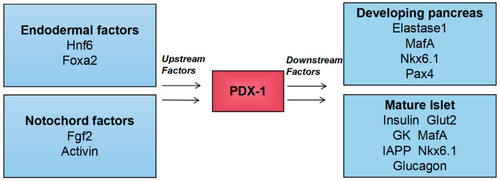Figures & data
Figure 1 Upstream regulator and direct downstream target of PDX-1. The figure highlights the central role of PDX-1 in the pancreas. Extracellular factors (Fgf2 and activin) derived from the notochord and intracellular factors (transcription factors Foxa2 and Hnf6) synergistically activate the expression of PDX-1 in the primitive intestinal endoderm.

Table 1 Correlations Between DNA Methylation of the Proximal and Distal Promoters as Well as Enhancer Regions of PDX-1 and Gene Expression in Human Donors
Figure 2 The cytosine methylation and demethylation system. 5methyl cytosine (5mC) is generated by the action of DNA methyltransferases (DNMTs). In specific contexts, likely driven by tissue-specific DNA-binding transcription factors, selected 5 mC residues are oxidized by TET enzymes to produce 5hmC (5-hydroxymethyl cytosine), which can be further oxidized to 5 fC (5-formyl cytosine) and 5caC (5-carboxy cytosine). Alternatively, 5fC and 5caC can be excised by thymidine DNA glycosylase (TDG) and repaired by the base excision repair mechanism to cytosine.

